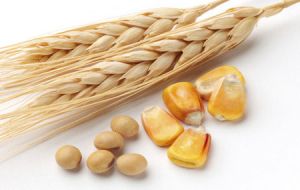MercoPress. South Atlantic News Agency
FAO Food Price Index down for the second consecutive month in May
 Maize and wheat prices dropped, while rice remained stable
Maize and wheat prices dropped, while rice remained stable The FAO Food Price Index was down for the second consecutive month in May, continuing its retreat from the 10-month high it experienced in March. Prices fell as generally ample supplies weighed on international prices for most commodities included in the Index.
Meanwhile, a companion monthly report, the FAO Cereal Supply and Demand Brief, shows the outlook for the global cereal supply in the 2014/15 marketing season has improved considerably since the previous report in May.
The Food Price Index, based on the prices of a basket of internationally-traded food commodities, averaged 207.8 points in May 2014, down 2.5 points (or 1.2%) from April, and nearly 7 points, or 3.2%, below the May 2013 level.
The Index had risen to a ten-month high of 213 points in March, but fell in April and May amid lower dairy, cereal and vegetable oil prices. Sugar prices went against the trend, making strong gains in May, while meat remained firm.
The FAO Cereal Price Index averaged 204.4 points in May, down 2.4 points (or 1.2%) from April and 30 points (or 13%) below last year. The decline in May was mostly triggered by maize prices, which fell in response to favorable growing conditions and good supply prospects in 2014/15. Wheat prices, which had contributed to price increases in previous months, partly amid fears of disruptions to trade flows from Ukraine, also fell, while rice prices saw little change.
“We went into May with concerns over unfavorable weather conditions, especially in the US, and geopolitical tensions in the Black Sea region, but towards the second half of May, we began to see lower wheat prices following improved weather conditions and the continuation of regular shipping patterns from the Ukraine,” said FAO Senior Economist Abdolreza Abbassian.
Vegetable oils averaged 195.3 points in May, down 3.7 points (or 1.8%) from April, reflecting lower quotations of palm, soy and rapeseed oils.
Following a period of limited export supplies and exceptionally high prices in 2013 and early 2014, the market for dairy commodities is undergoing some adjustment as the production outlook improves. The FAO Dairy Price Index averaged 238.9 points in May, representing a second sharp monthly fall, and a decline of 12 points (or 5%) over April.
Meat prices averaged 189.1 points in May, nearly unchanged from April.
Sugar was up, averaging 259.2 points in May, up 9.3 points (or 3.7%), from April, amid early forecasts of a possible production deficit for the 2014/15 season and El Niño-related weather concerns.
FAO's monthly update on the world cereal market, the Cereal Supply and Demand Brief, puts world cereal production in 2014 at nearly 2 480 million tons (including rice in milled terms), almost 1% (21.5 million tons) higher than was reported in May, though still 1.4% down from 2013.
Global production of coarse grains stands at 1 274 million tons, 18.6 million tons higher than reported in May, with most of the upward adjustment reflecting improved outlook for maize crops in the United States and bigger than earlier anticipated maize harvests in Argentina and Brazil.
World wheat production in 2014 is forecast at nearly 703 million tons, up marginally from the May forecast, though down from the previous year. Rice production in 2014 is expected to reach about 503 million tons (milled basis), 1.9 million more than foreseen last month, and 1.2% more than in 2013.
The forecast for world cereal stocks by the close of crop seasons ending in 2015 has been raised by almost 10 million tons since May, to 576 million tons. Based on the latest forecast, the global cereal stocks-to-use ratio could reach a 10-year high of 23.1%, up marginally from 2013/14.





Top Comments
Disclaimer & comment rules-

Read all commentsGood for people, bad for agri based economies like Argentina and Brazil. In the words of yankeeboy.....those socialist “monkeys” just do not understand the basic tenets of supply and demand.
Jun 09th, 2014 - 11:02 am 0Commenting for this story is now closed.
If you have a Facebook account, become a fan and comment on our Facebook Page!